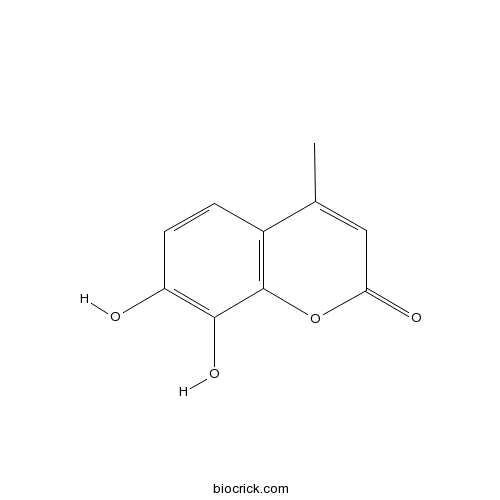7,8-Dihydroxy-4-MethylcoumarinCAS# 2107-77-9 |

Quality Control & MSDS
3D structure
Package In Stock
Number of papers citing our products

| Cas No. | 2107-77-9 | SDF | Download SDF |
| PubChem ID | 5355836 | Appearance | Powder |
| Formula | C10H8O4 | M.Wt | 192 |
| Type of Compound | Coumarins | Storage | Desiccate at -20°C |
| Solubility | Soluble in Chloroform,Dichloromethane,Ethyl Acetate,DMSO,Acetone,etc. | ||
| Chemical Name | 7,8-dihydroxy-4-methylchromen-2-one | ||
| SMILES | CC1=CC(=O)OC2=C1C=CC(=C2O)O | ||
| Standard InChIKey | NWQBYMPNIJXFNQ-UHFFFAOYSA-N | ||
| Standard InChI | InChI=1S/C10H8O4/c1-5-4-8(12)14-10-6(5)2-3-7(11)9(10)13/h2-4,11,13H,1H3 | ||
| General tips | For obtaining a higher solubility , please warm the tube at 37 ℃ and shake it in the ultrasonic bath for a while.Stock solution can be stored below -20℃ for several months. We recommend that you prepare and use the solution on the same day. However, if the test schedule requires, the stock solutions can be prepared in advance, and the stock solution must be sealed and stored below -20℃. In general, the stock solution can be kept for several months. Before use, we recommend that you leave the vial at room temperature for at least an hour before opening it. |
||
| About Packaging | 1. The packaging of the product may be reversed during transportation, cause the high purity compounds to adhere to the neck or cap of the vial.Take the vail out of its packaging and shake gently until the compounds fall to the bottom of the vial. 2. For liquid products, please centrifuge at 500xg to gather the liquid to the bottom of the vial. 3. Try to avoid loss or contamination during the experiment. |
||
| Shipping Condition | Packaging according to customer requirements(5mg, 10mg, 20mg and more). Ship via FedEx, DHL, UPS, EMS or other couriers with RT, or blue ice upon request. | ||
| Description | 1. 4-Methyldaphnetin is a potent inhibitor (low micromolar) of lipid peroxidation and scavengers of superoxide anion radicals and of aqueous alkylperoxyl radicals, but may be pro-oxidant (enhancing generation of hydroxyl radicals) in the presence of free iron ions. 2. 4-Methyldaphnetin inhibits the proinflammatory 5-lipoxygenase enzyme at micromolar concentrations. |
| Targets | LOX |

7,8-Dihydroxy-4-Methylcoumarin Dilution Calculator

7,8-Dihydroxy-4-Methylcoumarin Molarity Calculator
| 1 mg | 5 mg | 10 mg | 20 mg | 25 mg | |
| 1 mM | 5.2083 mL | 26.0417 mL | 52.0833 mL | 104.1667 mL | 130.2083 mL |
| 5 mM | 1.0417 mL | 5.2083 mL | 10.4167 mL | 20.8333 mL | 26.0417 mL |
| 10 mM | 0.5208 mL | 2.6042 mL | 5.2083 mL | 10.4167 mL | 13.0208 mL |
| 50 mM | 0.1042 mL | 0.5208 mL | 1.0417 mL | 2.0833 mL | 2.6042 mL |
| 100 mM | 0.0521 mL | 0.2604 mL | 0.5208 mL | 1.0417 mL | 1.3021 mL |
| * Note: If you are in the process of experiment, it's necessary to make the dilution ratios of the samples. The dilution data above is only for reference. Normally, it's can get a better solubility within lower of Concentrations. | |||||

Calcutta University

University of Minnesota

University of Maryland School of Medicine

University of Illinois at Chicago

The Ohio State University

University of Zurich

Harvard University

Colorado State University

Auburn University

Yale University

Worcester Polytechnic Institute

Washington State University

Stanford University

University of Leipzig

Universidade da Beira Interior

The Institute of Cancer Research

Heidelberg University

University of Amsterdam

University of Auckland

TsingHua University

The University of Michigan

Miami University

DRURY University

Jilin University

Fudan University

Wuhan University

Sun Yat-sen University

Universite de Paris

Deemed University

Auckland University

The University of Tokyo

Korea University
- 5,7-Dihydroxy-4-Methylcoumarin
Catalog No.:BCC8284
CAS No.:2107-76-8
- PD 168568 dihydrochloride
Catalog No.:BCC7702
CAS No.:210688-56-5
- 6alpha-Hydroxylycopodine
Catalog No.:BCN7403
CAS No.:21061-92-7
- 1,11b-Dihydro-11b-hydroxymaackiain
Catalog No.:BCN3914
CAS No.:210537-05-6
- 1,11b-Dihydro-11b-hydroxymedicarpin
Catalog No.:BCN3913
CAS No.:210537-04-5
- Sitaxentan sodium
Catalog No.:BCC4495
CAS No.:210421-74-2
- Odoratin-7-O-beta-D-glucopyranoside
Catalog No.:BCN8089
CAS No.:210413-47-1
- Spiradine F
Catalog No.:BCN4915
CAS No.:21040-64-2
- Cinnamyl acetate
Catalog No.:BCN4914
CAS No.:21040-45-9
- Z-LEHD-FMK
Catalog No.:BCC5117
CAS No.:210345-04-3
- Ac-LEHD-AFC
Catalog No.:BCC2359
CAS No.:210345-03-2
- Z-WEHD-FMK
Catalog No.:BCC1139
CAS No.:210345-00-9
- CP 471474
Catalog No.:BCC2373
CAS No.:210755-45-6
- Sakakin
Catalog No.:BCN4916
CAS No.:21082-33-7
- Org 12962 hydrochloride
Catalog No.:BCC7718
CAS No.:210821-63-9
- W-84 dibromide
Catalog No.:BCC6682
CAS No.:21093-51-6
- CART (62-76) (rat, human)
Catalog No.:BCC6008
CAS No.:210978-19-1
- BMY 7378
Catalog No.:BCC5063
CAS No.:21102-95-4
- Mahanimbine
Catalog No.:BCN3174
CAS No.:21104-28-9
- SB 265610
Catalog No.:BCC5936
CAS No.:211096-49-0
- Marsformoxide B
Catalog No.:BCN6687
CAS No.:2111-46-8
- Sobetirome
Catalog No.:BCC1957
CAS No.:211110-63-3
- Rubranol
Catalog No.:BCN4917
CAS No.:211126-61-3
- 9,17-Octadecadiene-12,14-diyne-1,11,16-triol
Catalog No.:BCN1497
CAS No.:211238-60-7
Infrared, Raman and NMR spectra, conformational stability and vibrational assignment of 7,8-Dihydroxy-4-Methylcoumarin.[Pubmed:24935826]
Spectrochim Acta A Mol Biomol Spectrosc. 2014 Nov 11;132:871-8.
We report a combined some (infrared, Raman and NMR) spectroscopic and quantum chemistry study on 7,8-Dihydroxy-4-Methylcoumarin molecule (78D4MC). The Raman and IR spectra of 78D4MC molecule were recorded and analyzed in the region 3500-50 cm(-1) and 4000-400 cm(-1), respectively. Potential energy scans were performed at the MMFF level of theory. All possible conformers, which are results at the MMFF level theory, were re-computed at the B3LYP functional with cc-pVDZ basis set. The optimized geometrical parameters, harmonic vibrational wavenumbers and NMR chemical shifts of the most stable conformer were calculated at the B3LYP/6-311G(d,p), cc-pVTZ and cc-pVQZ level in the proximity of the isolated molecule. DFT calculations were combined with Pulay's scaled quantum mechanics force field (SQMFF) methodology in order to fit the theoretical wavenumbers to the experimental ones.


